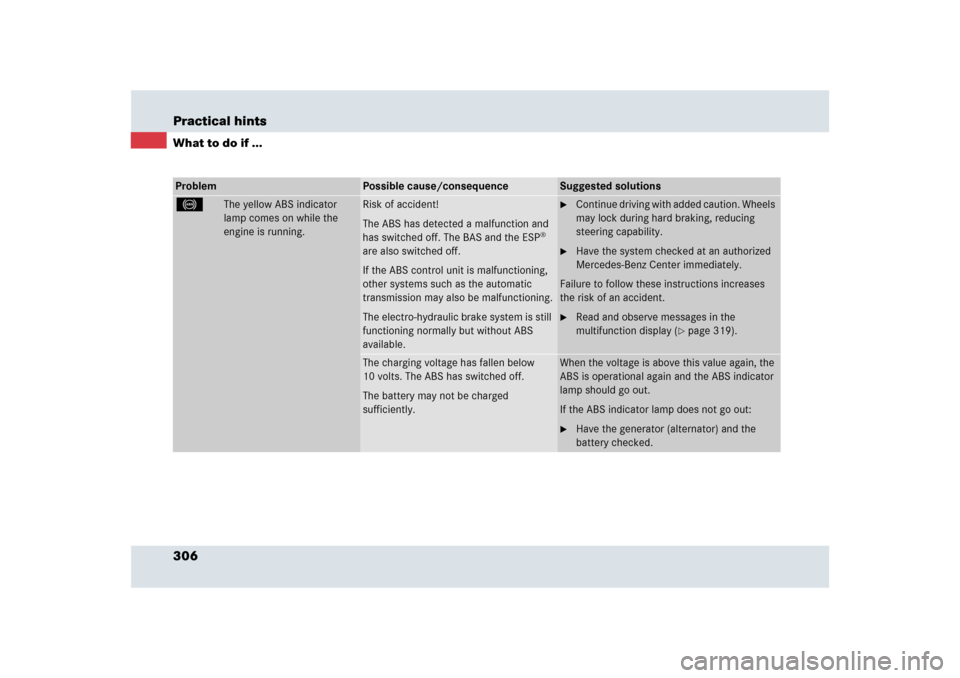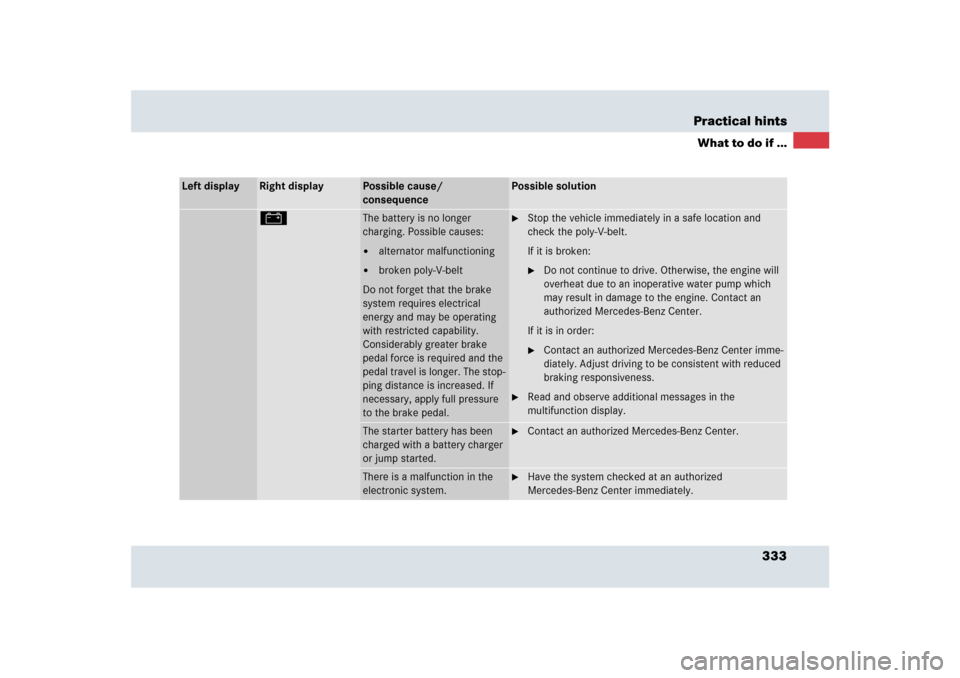Page 306 of 426

306 Practical hintsWhat to do if ...Problem
Possible cause/consequence
Suggested solutions
-
The yellow ABS indicator
lamp comes on while the
engine is running.
Risk of accident!
The ABS has detected a malfunction and
has switched off. The BAS and the ESP
®
are also switched off.
If the ABS control unit is malfunctioning,
other systems such as the automatic
transmission may also be malfunctioning.
The electro-hydraulic brake system is still
functioning normally but without ABS
available.
�
Continue driving with added caution. Wheels
may lock during hard braking, reducing
steering capability.
�
Have the system checked at an authorized
Mercedes-Benz Center immediately.
Failure to follow these instructions increases
the risk of an accident.
�
Read and observe messages in the
multifunction display (
�page 319).
The charging voltage has fallen below
10 volts. The ABS has switched off.
The battery may not be charged
sufficiently.
When the voltage is above this value again, the
ABS is operational again and the ABS indicator
lamp should go out.
If the ABS indicator lamp does not go out:�
Have the generator (alternator) and the
battery checked.
Page 332 of 426
332 Practical hintsWhat to do if ...Symbol messagesLeft display
Right display
Possible cause/
consequence
Possible solution
<
Airbrake
Malfunction
The Airbrake locking mecha-
nism is malfunctioning.
�
Contact an authorized Mercedes-Benz Center
immediately.
#
Battery/Alternator
Stop Car
The battery is malfunctioning.
The electro-hydraulic brake
system requires electrical
energy and therefore has only
limited operation. Considerably
greater brake pedal force is
required and the pedal travel is
longer. The stopping distance is
increased. If necessary, apply
full pressure to the brake pedal.
�
Stop the vehicle as soon as it is safe to do so. Adjust
driving to be consistent with reduced braking
responsiveness.
�
Do not drive any further.
�
Call Roadside Assistance.
�
Contact an authorized Mercedes-Benz Center
immediately.
Page 333 of 426

333 Practical hints
What to do if ...
Left display
Right display
Possible cause/
consequence
Possible solution
#
The battery is no longer
charging. Possible causes:�
alternator malfunctioning
�
broken poly-V-belt
Do not forget that the brake
system requires electrical
energy and may be operating
with restricted capability.
Considerably greater brake
pedal force is required and the
pedal travel is longer. The stop-
ping distance is increased. If
necessary, apply full pressure
to the brake pedal.
�
Stop the vehicle immediately in a safe location and
check the poly-V-belt.
If it is broken:�
Do not continue to drive. Otherwise, the engine will
overheat due to an inoperative water pump which
may result in damage to the engine. Contact an
authorized Mercedes-Benz Center.
If it is in order:
�
Contact an authorized Mercedes-Benz Center imme-
diately. Adjust driving to be consistent with reduced
braking responsiveness.
�
Read and observe additional messages in the
multifunction display.
The starter battery has been
charged with a battery charger
or jump started.
�
Contact an authorized Mercedes-Benz Center.
There is a malfunction in the
electronic system.
�
Have the system checked at an authorized
Mercedes-Benz Center immediately.
Page 383 of 426
383 Technical data
Layout of poly-V-belt drive
�Layout of poly-V-belt drive
The SLR has two poly-V-belts (belt one
shown in purple/belt two shown in black).1Idler pulley
2Automatic belt tensioner
3Power steering pump
4Air conditioning compressor
5Idler pulley
6Crankshaft
7Coolant pump
8Generator (alternator)
9Idler pulley
aAutomatic belt tensioner
bSupercharger
Page 390 of 426
390 Technical dataElectrical system
Mercedes-Benz SLR McLaren
Roadster
Mercedes-Benz SLR McLaren
Roadster 722 S
Generator (alternator)
14 V/150 A
14 V/150 A
Starter motor
12 V/1.7 kW
12 V/1.7 kW
Battery
Starter battery
12 V/35 Ah
12 V/35 Ah
Battery for electrical consumers
12 V/70 Ah
12 V/70 Ah
Spark plugs
NGK ILFR6A
NGK ILFR6A
Electrode gap
0.031 in (0.8 mm)
0.031 in (0.8 mm)
Tightening torque
18 – 22 lb-ft (25 – 30 Nm)
18 – 22 lb-ft (25 – 30 Nm)
Page 405 of 426

405 Technical terms
Instrument cluster
The displays and indicator/warning
lamps in the driver’s field of vision, in-
cluding the tachometer, speedometer,
engine temperature and fuel gauge.
Kickdown
Depressing the accelerator past the
point of resistance shifts the transmis-
sion down to the lowest possible. This
very quickly accelerates the vehicle
and should not be used for normal
acceleration needs.
Kilopascal (kPa)
(
�page 287)
Maximum load rating
(�page 287)
Maximum loaded vehicle weight
(�page 287)
Maximum tire inflation pressure
(�page 287)MON
(M
otor O
ctane N
umber)
The Motor Octane Number for gasoline
as determined by a standardized
method. It is an indication of a gaso-
line's ability to resist undesired detona-
tion (knocking). The average of both
the MON (Motor Octane Number) and
RON (Research Octane Number) is
posted at the pump, also known as
ANTI-KNOCK INDEX.
Multifunction display
Two display fields in the instrument
cluster used to present information
provided by the control system.
Multifunction steering wheel
Steering wheel with buttons for
operating the control system.
Normal occupant weight
(
�page 287)OCS
(O
ccupant C
lassification S
ystem)
The system automatically turns the
front passenger front air bag on or off
based on the classified occupant size
category determined by weight sensor
readings from the seat.
Overspeed range
Engine speeds within the red marking
on the tachometer dial. Avoid this
engine speed range, as it may result in
serious engine damage that is not
covered by the Mercedes-Benz Limited
Warranty.
Poly-V-belt drive
Drives engine-components (alternator,
AC compressor, etc.) from the engine.